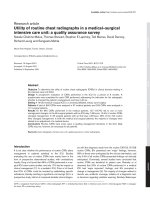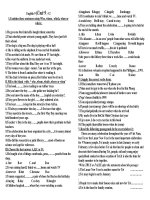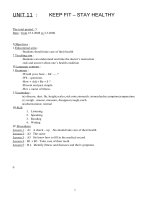unit volcanism
Bạn đang xem bản rút gọn của tài liệu. Xem và tải ngay bản đầy đủ của tài liệu tại đây (1.21 MB, 34 trang )
Volcanism
Volcano
• A vent (nyílás) or fissure (repedés) in the
surface through which molten material
from lower levels reaches the surface
Fissure, Shield, Dome,
Ashcinder(hamusalak), composite, caldera
Video – Different volcanoes
• Where can we find the most violent volcanoes?
• How do we call the layered cones?
• What are the Hawaiian islands good example for?
• Name the type of volcanoes that are large mountains
with gentle slopes, formed from basaltic lava.
Tectonic plate boundaries
The movement of magma
• Magma moves upwards
• Solidifies in the crust:
intrusive plutonic
rocks: granite, gabbro
• The temperature
decreases, the cooling
process is very slow: large
crystals
If magma reaches the surface =
volcanism
• Volcanoes = those points where
magma comes to the surface
• Magma = lava
• Rocks form during the cooling
of lava: volcanic rocks
(extrusive)
• Cool down quickly: small
crystals
Volcanic activity is connected with
plate boundaries
2 types of volcanic activity
Violent (explosive)
Not violent (effusive)
Accompanied by explosions
Simple outpourings of lava
onto the ground
Depends on the chemical
composition of magma
Different types of magma
Classification is based on the silica
content:
acid
High silica
content
intermediate
basic
ultrabasic
Low silica
content
Volcanoes and plate boundaries
I. Oceanic ridges
• 80 % of magma reaching the
surface
• From great depths
(asthenosphere)
• Very high temperature (1100
1200˚C)
• Lots of metallic elements in it
• Low silica content – BASIC
type
Plutonic rock
Volcanic rock
gabbro
basalt
Basaltic lava forms
• Runny
• Floods over large areas before
consolidating
1.Lava plains / plateaus
(Deccan Plateau)
2.Shield volcanoes with gentle
slopes (Hawaiian Islands)
Mauna Loa
Basaltic lava on the sea floor
• 1. outer skin cools down quickly
• 2. Inner part is still hot
• 3. breaking through the already
solidified outer crust
• Resulting form: PILLOW lava
Szarvaskő in the
Bükk mountains
Indicating the area
was sea floor
several millions of
years ago
II. Trenches: Convergent plates
• 1. subducting plate melts in the
increasing temperature
• 2. magma comes from the material
of the plate
• Lower temperature (800900˚C)
• Huge amount of sediment
Explosive volcanism
huge amount of sediment (a lot of
water!) also subducted – increases the
pressure and gas content of magma
Lava
• Viscous, flows less quickly
• Steeper slopes
• Gas content is higher –
explosions
• Large amount of volcanic
sand and rock fragments is
thrown out: pyroclast
Intermediate (silica Acid (silica content of
content of 52 to 56 %) m ore than 65%)
Diorite (plutonic)
Granite (plutonic)
Andesite (volcanic)
Rhyolite (volcanic)
Composite volcano
• Usually composed of andesite rocks
Layers of:
– Andesite (lava flow)
– andesite tuff
crater
Vent (main,
secondary)
Magma chamber
Andesite tuff
• A kind of pyroclast
• Airborne debris
• Consisting of volcanic dust and andesite
fragments
Etna (Sicily), Fuji (Japan)
Caldera
• Broad and shallow depressions
• (E.g. Mt.St. Helens)
The result
of
explosions









